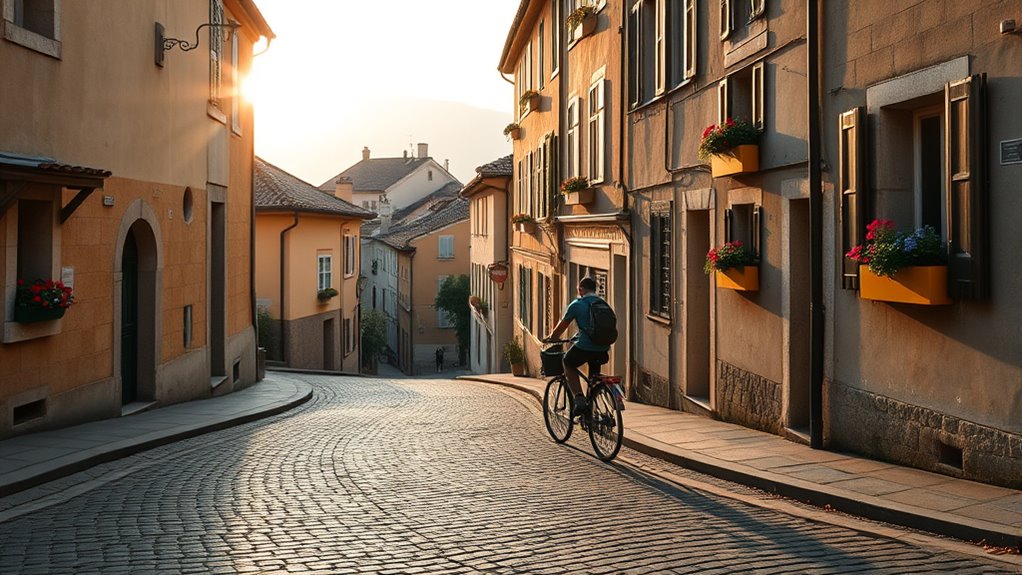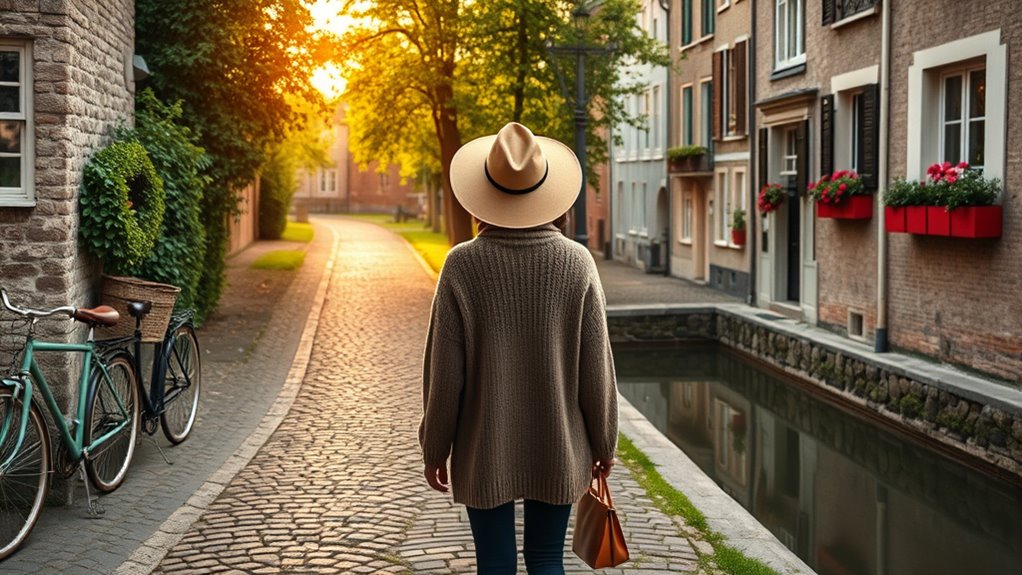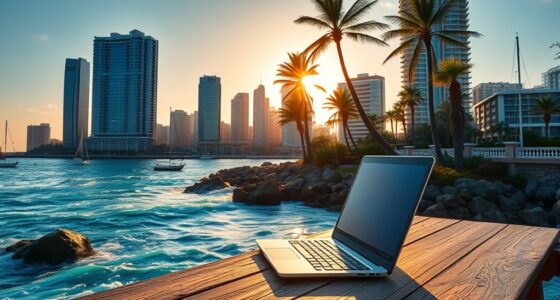To see more by moving less, embrace slow travel by spending more time in each place and engaging deeply with your surroundings. Focus on authentic experiences like exploring local markets, trying regional foods, and chatting with residents. Take the time to notice details in architecture, sounds, and customs. Prioritize quality moments over rushing through sights. If you keep exploring, you’ll discover even more secrets that make your journey richer and more memorable.
Key Takeaways
- Focus on longer stays in fewer locations to deepen cultural immersion and reduce transit time.
- Prioritize local experiences like markets, workshops, and community spaces over tourist attractions.
- Use slow transportation methods such as walking, biking, or local transit to explore authentically.
- Engage with locals through conversations and shared meals to gain genuine insights and connections.
- Practice mindfulness and presence to notice subtle details and create meaningful, memorable moments.

Ever wondered how to make your travels more meaningful and less rushed? The secret lies in embracing slow travel, a mindful approach that allows you to truly connect with your destination. Instead of rushing from one tourist spot to the next, take your time to absorb the atmosphere, listen to local stories, and savor each moment. This approach isn’t about seeing more in less time; it’s about experiencing more deeply, which often means moving less. When you slow down, you open the door to authentic encounters and genuine cultural immersion. Engaging in mindfulness and presence enhances your ability to notice the subtle details that make each place unique.
One of the best ways to deepen your travel experience is by exploring local cuisine. Instead of sticking to familiar chain restaurants or quick bites, seek out small cafes, street food stalls, and family-run eateries. These places often serve dishes rooted in tradition, giving you a taste of the region’s history and identity. By taking the time to enjoy a leisurely meal, you not only nourish your body but also foster connections with locals who are happy to share their culinary stories. Such experiences turn a simple meal into a memorable cultural exchange, enriching your understanding of the place you’re visiting.
Explore local eateries for authentic flavors and meaningful cultural exchanges.
Cultural immersion is another pillar of slow travel. When you move at a relaxed pace, you’re more likely to engage with the community around you. Attend local markets, participate in workshops, or simply sit in a park and observe daily life. These small, intentional actions allow you to see beyond the typical tourist attractions and gain insight into the customs, traditions, and everyday routines of the people who live there. By doing so, you develop a deeper appreciation for the culture and create more meaningful memories. Moving less doesn’t mean missing out; it means opening yourself up to the stories and realities that make each place unique.
Another advantage of slow travel is the chance to develop relationships. When you avoid the rush, you give yourself the opportunity to converse with locals, learn their perspectives, and hear their stories firsthand. These interactions often lead to authentic friendships, insider tips, and a richer experience overall. The more you slow down, the more you notice the details—the architecture, the sounds, the smells—that make a destination special. This mindful approach encourages you to savor not just the sights but the essence of a place, fostering deeper connections and understanding. Incorporating a mindful travel mindset can help you stay present and fully engaged with your surroundings.
In essence, slow travel is about valuing quality over quantity. It’s about making space for genuine engagement, whether through tasting local cuisine, participating in cultural activities, or simply being present. When you move less, you allow yourself to see more—more meaning, more connection, more joy. And ultimately, that’s what makes travel truly rewarding. Incorporating the principles of mindfulness and presence can greatly enhance your experience, helping you to stay connected and fully immersed in each moment. Additionally, understanding cost and budgeting can help you plan more sustainable and enriching trips without overspending, allowing you to focus on meaningful experiences rather than expenses.
Frequently Asked Questions
What Are the Best Slow Travel Destinations Worldwide?
You’ll love exploring destinations that prioritize local cultural immersion and sustainable travel tips. Consider slow travel hotspots like Italy’s Tuscany, Japan’s Kyoto, or Spain’s Andalusia, where you can savor authentic experiences at a relaxed pace. These places let you connect deeply with local traditions, while reducing your environmental impact. By moving less and staying longer, you’ll uncover hidden gems, enjoy meaningful interactions, and travel more consciously.
How Can I Afford Longer, Slower Trips?
Did you know travelers spending more time in one place often save up to 30% on costs? To afford longer, slower trips, focus on budget planning by researching affordable accommodations and local eats. Embrace cultural immersion by engaging with communities and participating in free or low-cost activities. These strategies help you stretch your travel funds, making extended adventures more accessible and enriching without breaking the bank.
What Gear Is Essential for Slow Travel Adventures?
For slow travel adventures, you need essential gear like a durable backpack and versatile clothing. Packing tips include choosing lightweight, multi-use items to save space. Carry a compact first aid kit and a reliable water bottle. Keep your gear in top shape with regular gear maintenance, ensuring everything functions well during your trip. This approach helps you travel comfortably and efficiently, making your slow travel experience more enjoyable and less stressful.
How Do I Stay Connected While Traveling Slowly?
To stay connected while traveling slowly, embrace digital nomadism by choosing accommodations with reliable Wi-Fi and portable hotspots. Use local cafes or co-working spaces for cultural immersion and networking. Keep your devices charged and backed up, and consider offline maps and translation apps. This approach helps you maintain connections, work seamlessly, and fully immerse yourself in local culture, making your slow travel experience richer and more integrated.
What Are Common Challenges in Slow Travel and Solutions?
You might face challenges like balancing cultural immersion and local cuisine with comfort and convenience. To overcome these, plan your stays thoughtfully, choosing accommodations that foster authentic experiences. Embrace local markets for cuisine and connect with residents to deepen your understanding. Staying flexible and patient helps you enjoy slow travel’s benefits, making it easier to savor local culture and cuisine without feeling overwhelmed or disconnected.
Conclusion
Now that you know the secrets of slow travel, imagine the moments waiting just around the corner—those unexpected sights, authentic connections, and quiet experiences that rush past when you move too fast. The real magic isn’t in rushing through destinations but in savoring each pause. But here’s the question: are you ready to slow down and discover what’s truly waiting for you? Sometimes, the most unforgettable adventures come when you least expect them—if you’re willing to take it slow.









